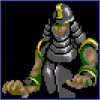Damn, those layer lines are clean. Link to STL?
The layer shifting is pretty severe in this print!
In case you were curious, like is was, the walls are 16 to 20 m (52 to 66 ft) tall.
I wonder, the walls may be even thinker than they are tall at the bottom
Hard to understand the scale.
According to the Wikipedia article on the history of Bukhara:
After the fall of the Kushan Empire, Bukhara passed into the hands of Hua tribes from the Mongolian steppe and entered a steep decline. However, the 5th century saw an unprecedented growth in urban and rural settlements throughout the entire oasis. Around this time the whole oasis territory was surrounded by a more than 400 km long wall.
I assume this structure dates to that period of construction?
I wonder whether this Kushan empire is the inspiration for the name of the protagonist’s tribe in the Homeworld videogame series.
Was there any advantage to having it lean like that?
In defensive terms, no, not really. They had to build it like this because these aren’t really walls per se, it’s just brick lining on the outside of an earthen mound, and mounds are, well, mound-shaped. https://gomadnomad.com/wp-content/uploads/2013/02/Bukharas-Ark-Palace.jpg
It would’ve made siege ladders harder to set up.
Who needs siege ladders when you can just climb up the damn wall?
You’d think there’d be a reason beyond construction requirements, though—otherwise someone in the past 1,500 years would have replaced it with a more conventional wall.
They did. This is only the oldest, innermost fortification in the city. AFAIK additional layers of walls were build around it later.
Is it a lean, or is it wider at the bottom?
This question confuses me geometrically
is it \ or △ shaped ?
It’s _/‾‾‾‾‾‾‾‾‾‾‾‾‾‾‾‾\_ shaped. It’s not freestanding walls, the whole thing is an earthen mound with a flat top and its sides lined with bricks.
So it’s not walls then I suppose. Just the slopes of a flat topped pyramid like thing. I mean, it still provided a height advantage, but it feels like they have lesser cover from arrows than they would have if it was like a conventional wall.
Pure speculation - a typical siege strategy was to dig under walls to cause them to collapse. First, the earthen mound would make the tunneling to collapse a much more labor intensive effort. Second, if an enemy was at the base of the wall it could actually be easier to hit them with projectiles at this angle rather than leaning over and aiming straight down.
Again, I have zero evidence to support these points, just spitballing here.
The tunneling issue makes sense. The wall will be much more stable because of the greater base area, and the sappers will need to dig a much bigger cavity under the wall for all the additional material to fall into - if the holes too small the wall might not collapse well enough for the ground forces to have a good opening to assault.
The second point is less convincing though. Forts and castle walls had mitigation for that extra issue - machicolations are an example. Often, arrows wouldn’t be used for killing the people right at the base of the wall, instead rocks or hot sand would be used to fuck up their day. These also took out armored units - rocks just, well, crushed them, and hot sand got in the gaps and visors and burned the shit out of them. They could also often not get rid of it without taking off the armor, so they just burned till the sand cooled down.
Also arrows were a manufactured commodity. Rocks were just taken from the land, or could be waste from quarries etc, and sand is rough, coarse, and everywhere.
Harder to knock down or undermine?
Not this one, but newer forts were built with angled walls to help protect against canon balls and the like.
But there the walls were still vertical to the ground yeah?
You’d think it would lean the other way to make bit harder to climb.
Edit: or this could be a view from the inside. Or maybe the goal is to keep people in rather than out.
Edit again: none of these things seem true according to Wikipedia. It’s curved inwards and it houses the rich, so it seems to just be aesthetics.
Are we sure they built it like that 1500 years ago? Churches can suck down in the span of only a few hundred years.
Wikipedia says it was built around the 5th century
The whole thing is basically a wall-clad hill. heaping one stone onto another is something they managed even thousands of years ago. And the climate (it is an oasis in the desert) is dry enought to keep it from eroding.
Well clearly it’s because the castle defenders of that era were quite sophisticated, but simply don’t dance they just pull up their pants and do the rockaway.
Harder to get on the wall would be my guess
Seems to me it’d be a lot easier to scale this incline than a vertical wall
It’s gregnant
What does it take to get you very interested? This is pretty amazing to me.
Very cool. Cross-posted to !castles@lemm.ee, where you can find more ancient structures.
Hi there! Looks like you linked to a Lemmy community using a URL instead of its name, which doesn’t work well for people on different instances. Try fixing it like this: !castles@lemm.ee
Good bot! I had a feeling I was messing that up.
Prince Siyawush built the Ark of Bukhara and was eventually buried there.
Ok, saying a fortress in Sogdia was built by Siyavash is like saying a fortress in Britain was built by Arthur or a fortress in Greece was built by Hercules—it’s what the locals say when they forgot who really built it.
not to mention the hundreds of slaves/peons/peasants that built it. they also get forgotten!
This is super interesting! Not just mildly. :)
Needs to cut down on the baklava.
deleted by creator
Ark of Rolling Shutter
People accomplished so much without TV and Internet.
Slavery gets shit done.
The front gate of the castle is huge and impressive, but the backside is like those toddlers with the open ass-flap in ancient Disney-movies.
















